What’s New for the Producer’s Bottom Line
BY AsphaltPro Staff
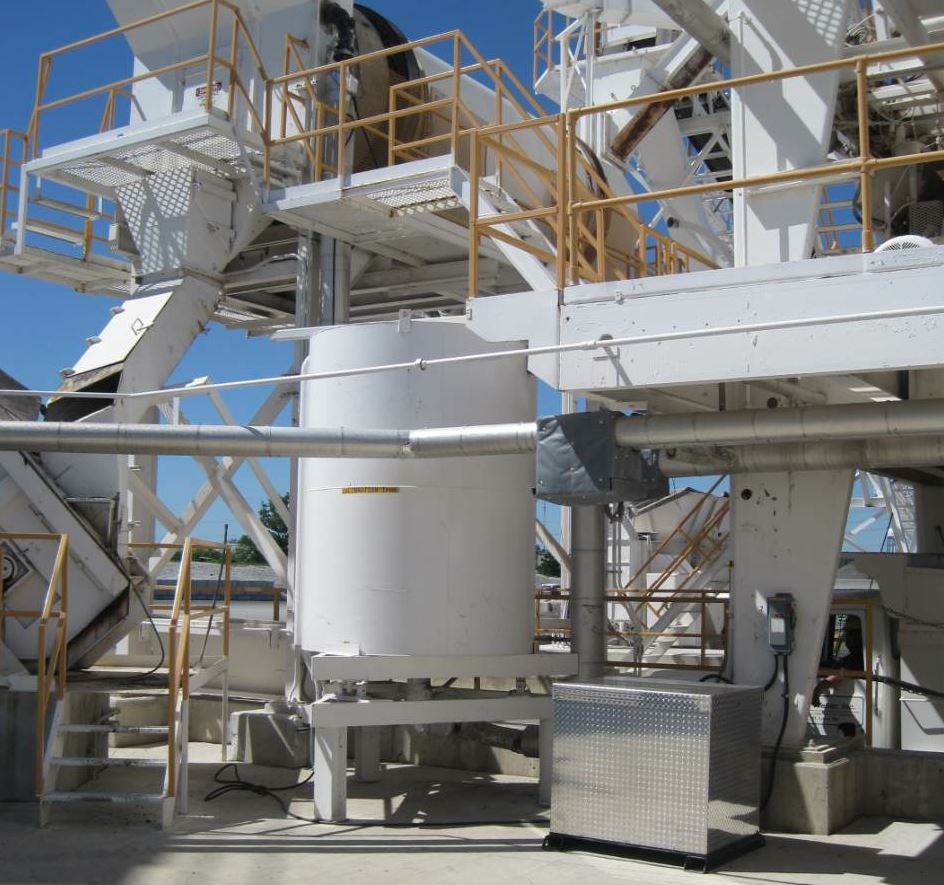
Discussing the asphalt plant and aggregate operations this month includes a look at trucking. MyLogic Inc., headquartered in Pennsylvania, has released a free app called Dump Truck Math, which is available on iOS and Android devices, to help estimators, foremen, and truck drivers streamline simple hauling calculations. The app started as an Excel spreadsheet MyLogic President Steve Kolbe created to simplify his own job, but his colleagues also wanted to use.
“Most people in the industry just work through the math on paper with a calculator,” Will Kolbe said. He’s the marketing director for MyLogic and Steve’s son. “But there are many variables and this app helps simplify some basic calculations that truck drivers and contractors use every day.”
Currently, the app offers three core calculations.
1. Rate per ton or cubic yard—This tool can be used to convert your hourly rate into a tonnage rate, factoring in tolls, travel time, loading time and unloading time.
2. Number of trucks needed—This calculator uses the time each round-trip journey takes to determine how many trucks will be needed for a particular job. This can help avoid lines of trucks at the plant or in front of the paver, as well as the need to stop the paving train to wait for the next truck to arrive.
3. Haul cost difference between two sites—This tool can be used to calculate the cost difference between multiple dump or load sites. For example, if Plant A is closer to the job site, but the cost per ton of mix is higher than that of Plant B, this calculator will help you determine if it makes financial sense to go the extra few miles to Plant B. It takes into consideration how much each truck is paid, how much it can carry and its drive time.
There is currently no way to archive or share calculations from within the app; Kolbe said all the inputs and outputs can fit on one page, making it easy to take a screenshot to save for your records or to share with others on the job.
Through word-of-mouth alone, the app had nearly 1,000 downloads in its first month. According to Kolbe, they’ve received great feedback so far. They’ve also received suggestions that they plan to take into account in future app updates. For example, one customer asked for a tool to calculate how much of a particular material would cover a particular area.
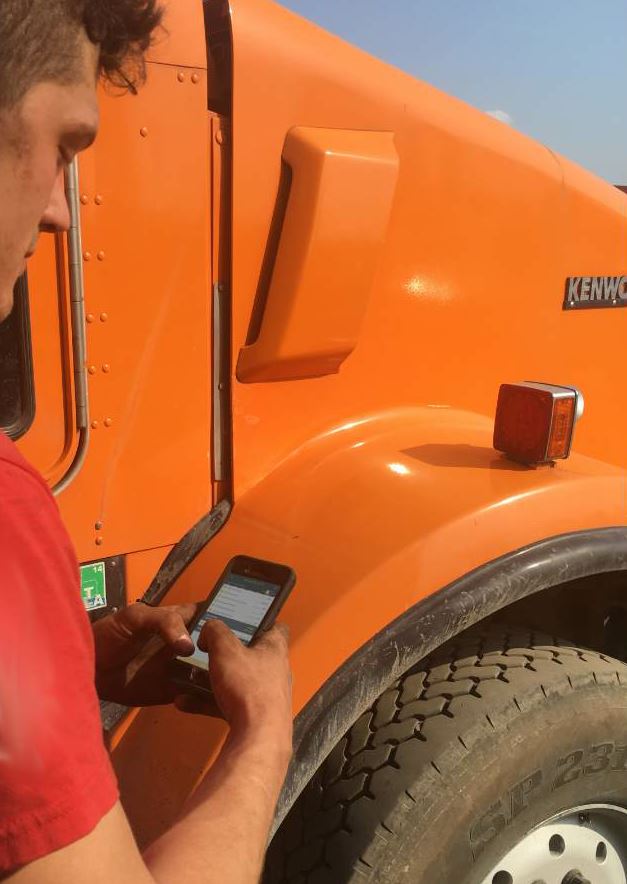 “We’re giving thought to ideas like that for the next update down the road,” Kolbe said, including other calculations that will benefit the construction industry. “But, we knew at launch we wanted the ones most people will be using on a day-to-day basis.”
“We’re giving thought to ideas like that for the next update down the road,” Kolbe said, including other calculations that will benefit the construction industry. “But, we knew at launch we wanted the ones most people will be using on a day-to-day basis.”
MyLogic also launched DumpTruckLoads.com back in February 2015. The website gives contractors a place to post their upcoming hauling needs, and a place for truck owners to search for jobs. Once a job—a load—is posted by a contractor, trucking companies with the kind of truck suited for the haul will be notified by text or email, and can contact the contractor directly to arrange scheduling and payment.
These days, DumpTruckLoads.com sends more than 80,000 load alerts each month to the owners of nearly 100,000 dump trucks across the United States, according to the company.
“After a lifetime in the industry, my dad saw this inefficiency where people really only had three options: someone from the company would spend hours on the phone tracking down the trucks they needed for a job, they could post ads on something like Craigslist, or they could work with brokers who would take a cut, either charging the contractors more or paying the truckers less,” Kolbe said. He added that general freight load board websites also weren’t offering the best user experience. “They treat dump trucks like an afterthought. That just doesn’t work because they are very different industries with unique variables. For example, asphalt is a time-sensitive material and the freight industry load boards didn’t address [that].”
Additionally, many of those services are simply tech-enabled brokerage firms, taking a cut of each transaction. DumpTruckLoads.com is free to all users.
According to Kolbe, the launch of Dump Truck Math is the first in a series of announcements to come this year. For example, DumpTruckLoads.com soon will expand into Canada and Mexico. Kolbe said all new products will keep MyLogic’s chief goal in mind: to improve efficiency while keeping things simple.
“Whether that helps save money on insurance or get things done faster and easier,” Kolbe said. “Everything we do is trying to solve these simple inefficiencies. There’s no fancy technology behind it, they’re just common sense solutions to common problems in the industry.”
Other “common” and not-so-common solutions for producers keep hitting the marketplace. To follow are recent developments to help asphalt and aggregate producers solve problems and enhance the bottom line.
Asphalt Drum Mixers Inc.
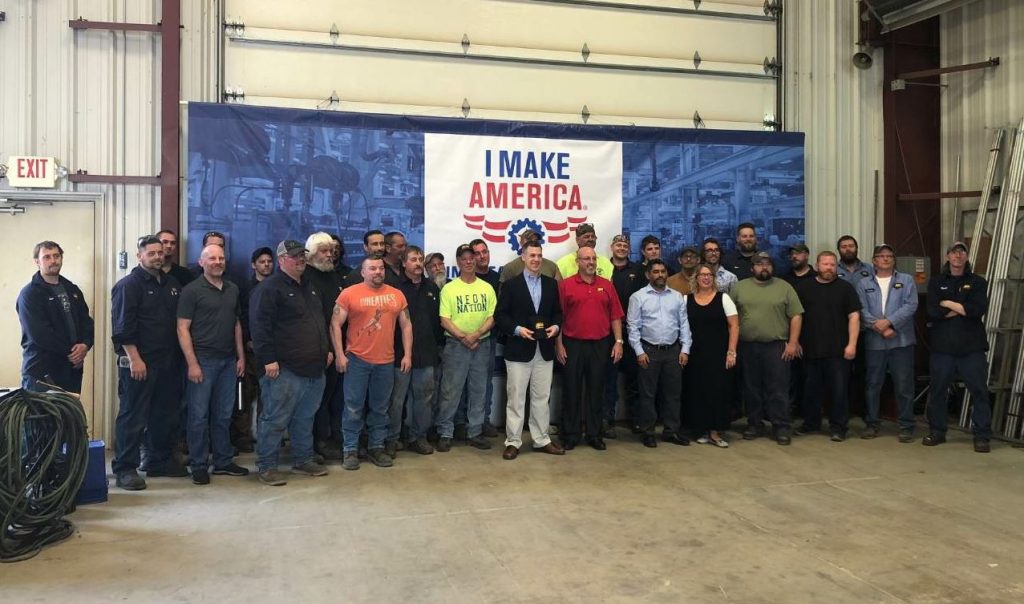
U.S. Representative Jim Banks poses for a group photo with employees at ADM’s facility in Huntertown, Indiana. ADM invited the congressman through the AEM “I Make America” program. Photos courtesy Asphalt Drum Mixers.
Asphalt Drum Mixers Inc. (ADM), Huntertown, Indiana, is not only making production equipment and components, it’s making a difference for highway funding. Members of the ADM team talked with the company’s U.S. House representative about issues important to the manufacturing industry during an “I Make America” event. Rep. Jim Banks toured ADM’s Huntertown facility May 2, answering questions from workers and sitting down for a one-on-one conversation with company president Mike Devine. The conversation centered largely around the significance of manufacturing in America, specifically to Indiana.

“It was an honor to host Congressman Banks at our facility,” Devine said. “We’ve always been proud to manufacture our products in America, and it’s important for our representatives to understand the impact of local manufacturing to the workforce and their communities. Because he’s serving his first term, this was an opportunity to communicate to the congressman how critical manufacturing is to his district.”
In addition to stressing the importance of manufacturing in America, Devine and Banks also discussed the need for infrastructure spending and the Highway Trust Fund, which Devine noted directly impacts many of the manufacturers in the district.
Astec Mobile Screens
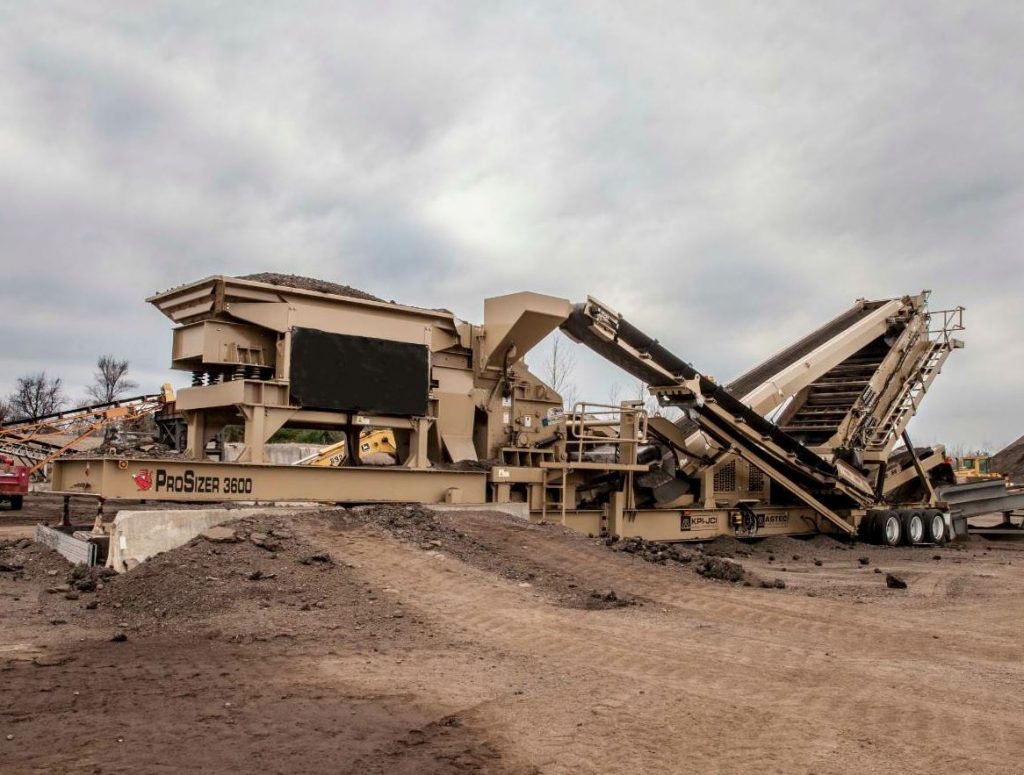
The new remote control option on Astec Mobile Screens’ swing-out conveyor lets operators build a third pile from the top deck overs material.
Astec Mobile Screens, Sterling, Illinois, announces its portable ProSizer® plants have been updated with a swing-out conveyor that now features an optional remote control. The additional conveyor gives producers that ability to make a third, stockpiled product from the top deck overs material. The conveyor can also return material to the crusher, allowing the plant to run in closed circuit.
The conveyor can also be used to remove waste material that is caught in the circuit by running the plant in open circuit for a short time until the material is cleared. With the new remote control option, operators can reduce downtime by clearing the debris without having to leave their loader or excavator.
For more information, contact Patrick Reaver at preaver@astecmobilescreens.com.
Continental
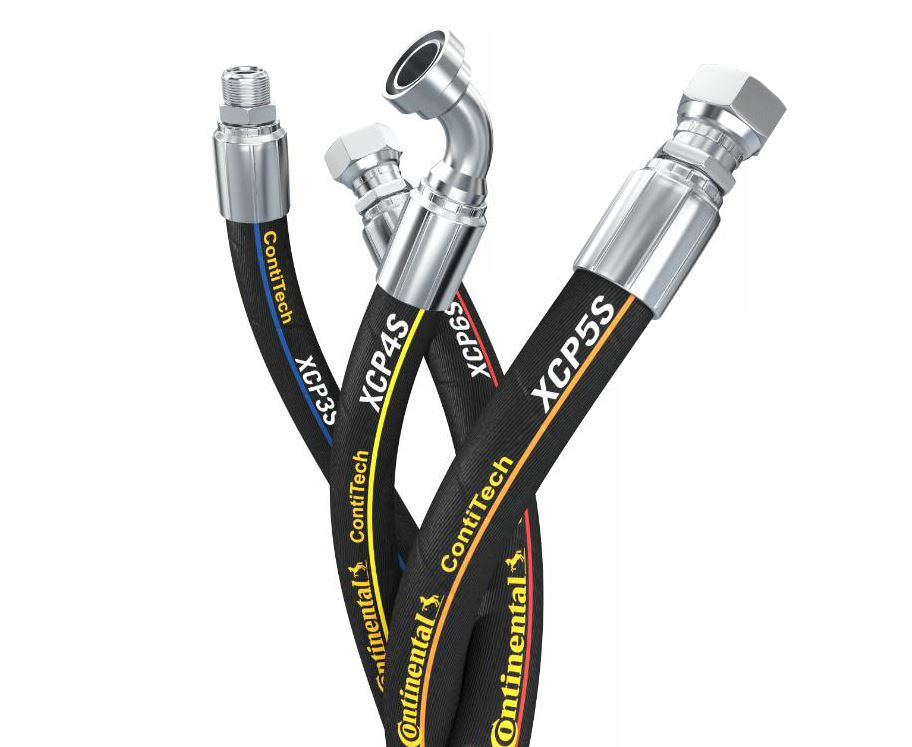
Continental has developed and introduced an intelligent crimper controller for distributors and customers in the hydraulic and industrial hose markets.
Technology company Continental has developed and introduced an intelligent crimper controller for distributors and customers in the hydraulic and industrial hose markets. “This new, exclusive crimping technology will enable Continental to provide the customer with instantaneous updates to the crimper thereby reducing costly downtime and offering a new level of enhanced efficiency, safety, quality and speed to our customers’ operations,” said Andreas Gerstenberger, head of the Industrial Fluid Solutions global business unit. Continental crimpers equipped with CrimpIQ controllers are designed to provide instantaneous maintenance information and updates for users who crimp hydraulic and industrial hose.
The monitoring process of this new, innovative Continental crimper is entirely cloud-based. “You will be able to oversee the entire process via a private security-protected Internet site,” Gerstenberger said. “CrimpIQ controller is the next step for Continental, our distributors and customers to become true system and solution partners for hose assembly related services. We believe that the CrimpIQ controller will do the same thing for the hose industry as the smart phone did to enhance our connectivity in our daily lives.”
The new CrimpIQ controller will be available on the following production crimpers: PC200, PC400, PC440, PC600, PC1000 and PC1200. As an example: This means the customer can crimp hydraulics hoses up to 2 inches on PC200 crimper or industrial hoses up to 12 inches on the PC1200. This range of crimpers can crimp fittings onto a majority of industrial hoses, according to the manufacturer.
For more information, contact Anthony DiGiacobbe at (330) 664-7124 or Anthony.digiacobbe@contitech.us.
Epiroc
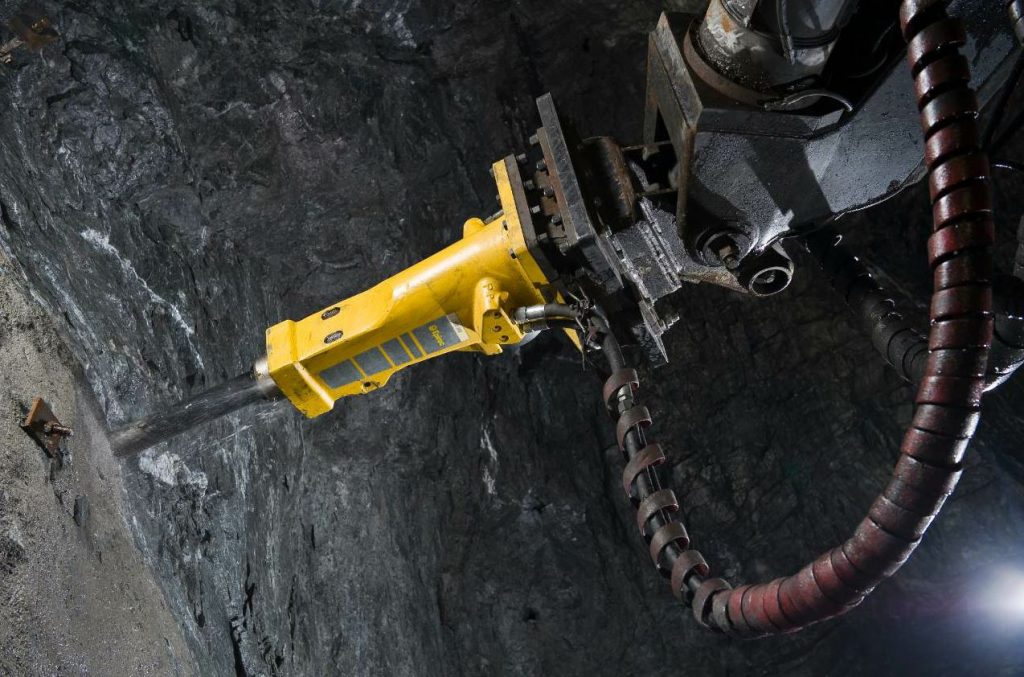
The SB 302 from Epiroc has a service weight of 690 pounds.
Epiroc, headquartered in Stockholm, Sweden, offers a new tunnel version of the Epiroc SB hydraulic breakers. The new SB 302 and SB 452 tunnel versions are designed to provide application-specific modifications to extend equipment life and reduce operating costs in underground applications. Readers with vertically integrated aggregate operations will be interested to know the piston lifetime in the advanced tunnel version is extended by a new piston in stainless steel; the bushing seat wear is minimized by a press-fit, one-piece bushing locked by an additional pin.
An exchangeable wear plate protects the hammer body. The special tunneling tool with a collar supporting a front shield and dust cover minimizes the dust intake when working on overhead areas. The new tunnel versions are designed for excavators in the weight class from 4.5 to 13 tons and standard underground scalers. Service weights are 690 pounds for the SB 302 and 990 pounds for the SB 452.
For more information, contact Rich Elliott (844) 437-4762 or rich.elliott@epiroc.com.
Microcranes Inc.

The M1 Global microcrane is 30 inches wide for transporting, then unfolds from the sides and back for stabilization.
Microcranes Inc., Vancouver, Washington, has introduced the ISO certified M1 Global Model Microcrane®, designed to fit through 36-inch doorways. Plant owners who need a crane on-site for maintenance or other work will be pleased to know the new M1 Global hydraulic pick & carry portable crane is rated at 2,000 pounds, and requires no operator license, according to the manufacturer.
It has a hook height of 20 feet, 3 inches. The machine is 30 inches wide and weighs 1,800 pounds with 300 pounds of removable counterweights to reduce weight while transporting. The machine unfolds from the sides and back for stabilization, and the four-piece boom extends to a 22-foot tip height.
Users can raise and lower the hydraulic boom with hand controls, and raise or lower live loads with a DC power winch. The line speed is 30 feet per minute.
For more information, visit www.microcranes.com.
Neal Manufacturing

Neal Manufacturing offers long-term storage solutions for up to 10,000 gallons of material.
Neal Manufacturing, a division of Blastcrete Equipment LLC, Charlotte, North Carolina, offers its storage tanks as long-term storage solutions for up to 10,000 gallons of material including asphalt emulsions with its skid-mounted sealer mixer tanks. Neal Manufacturing designs its storage tanks with I-beam or channel steel skids. For extra support, the company manufactures the tanks with corner braces to keep them securely fastened on the skids.
The agitators are manufactured with a solid steel shaft to mix thicker materials and break up settled product. With offset agitation, two of the three blades are submerged in the material at all times. Neal Manufacturing uses a 100-tooth sprocket to propel the agitation. A Ranger™ gear pump transfers materials out of the tank and into sealcoating equipment. Users operate both the pumping and mixing functions from one control panel.
For more information, contact (770) 830-1282 or eric@nealequip.com.
The WMA Section
Astec’s Generation 3 Warm-mix System
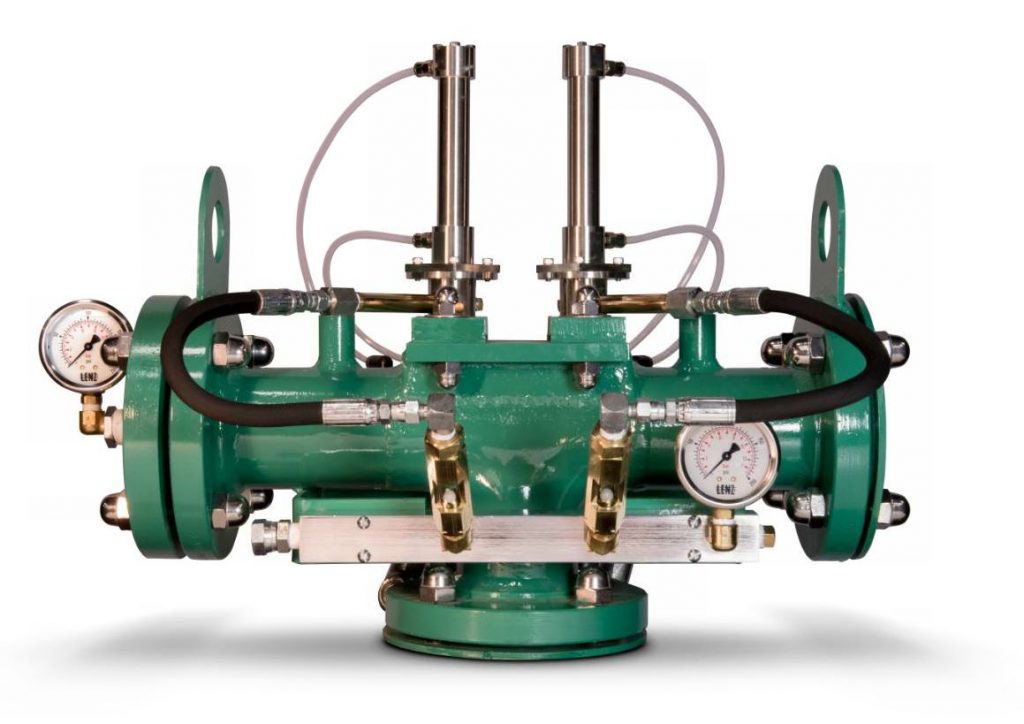
The Generation 3 from Astec uses a flow splitter plate to force liquid AC to encounter the water spray nozzles within the system.
As the industry’s use of warm-mix asphalt (WMA) increases, options for foaming the liquid asphalt cement (AC) meet new technology. The team from Astec Industries, Chattanooga, Tennessee, released the Generation 3 warm-mix system December 2017 to allow producers to make WMA mix designs without chemical additives. Here’s how it works.
The Gen3 apparatus is installed inline so the heated liquid AC enters the system easily. It uses a flow splitter plate to ensure the AC encounters both water spray nozzles in the system.
As the liquid AC enters the Gen3 manifold, it is directed above the splitter plate adjacent to two water injection valves. Electric over air solenoids open and close self-cleaning water valves to inject water supplied via an aluminum manifold.
As water flashes to steam and mixes with liquid AC, it foams and expands through an orifice plate and into the mixing device.
For more information, contact Astec Parts at (800) 251-6042.
CMI’s Warm Mix Asphalt System
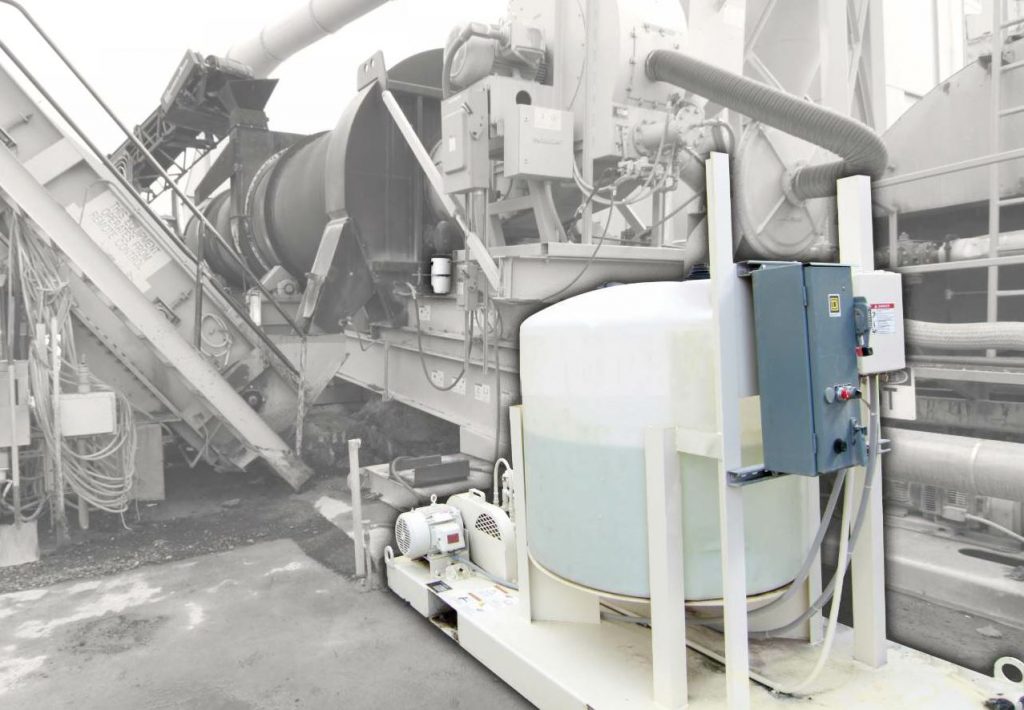
The warm mix asphalt system from CMI Roadbuilding is installed in the existing AC line.
The single-point injection system from CMI Roadbuilding Inc., Oklahoma City, Oklahoma, is designed to lower mix temperatures by up to 90 degrees F, thus reducing emissions while allowing the foamed binder to more thoroughly coat aggregate. Here’s how it works.
A PLC control system controls the liquid asphalt cement (AC)-to-water mix ratio. A 5-horespower variable-frequency motor driving positive displacement water pump moves water from the 200-gallon tank, through a filter, to the patented mixing chamber.
A water meter and calibration valve are designed to ensure mixing accuracy. Solenoid valves control the flow of water and prevent reverse flow of AC into the water line. In the mixing chamber, water and AC meet for foaming action. The manufacturer states: “Patented mixing chamber provides consistent AC/water mixing at any production rate.”
For more information, contact kevin.smith@cmi-roadbuilding.com.
Gencor’s Green Machine
The Ultrafoam GX2 from Gencor, Orlando, is designed to inject steam into the foaming process using only the energy of the pump or head supplying the liquid asphalt cement (AC) and water for warm-mix asphalt (WMA) production. Here’s how it works.
A small percentage of water—1 to 2 percent by weight—is injected into the center of the AC flow by a positive displacement water pump. According to the manufacturer, the pumping system provides all of the mixing energy. The Ultrafoam GX2’s centrally loaded water valve opens when the pressure of the water is impressed behind the valve.
A diaphragm plate introduces and directs the flow—and rate of flow—of AC to the process, and a special valve design prevents the AC from back-flowing into the water piping system. The fingers of the diaphragm deflect, allowing for increased flow area as the flow of the AC increases. All the while, the AC flow stream is directed toward a center nozzle.
The AC flow converges to the center of the injection point of the water. According to the manufacturer, this allows the Ultrafoam GX2 to maintain a perfect ratio of AC and water at all production rates and creates small, stable bubbles for consistent asphalt foaming.
For more information about the Ultrafoam GX2 technology, contact Dennis Hunt at (407) 290-6000 or visit www.gencorgreenmachine.com.
Maxam’s AquaBlack®
Provided by Maxam
Water enters Maxam’s AquaBlack® system through a particulate filter and mineral inhibitor, passing into a float valve controlled storage tank. A variable speed, high pressure pump draws water from the tank, passing it through all stainless steel plumbing to a stainless steel Coriolis mass flow meter which, by computer control, maintains the water flow rate to correspond with the plant’s liquid asphalt flow rate.
After passing through the flow meter, the water is directed under high pressure (up to 1000 psi) to the foaming head. At the foaming head, water is forced through high pressure atomizing nozzles, injecting microscopic water droplets into the plants liquid asphalt line.
The injection of microscopic water droplets results in the formation a very small micro-bubbles which stay in the mix throughout the mixing and paving process—essential for keeping the mix flexible and workable until compaction.
After shutdown, the systems automatic air purge removes all water from the system to prevent freezing during cold weather operation.
For more information, contact Maxam at (800) 292-6070.
Meeker’s Warm Mix Systems
Warm-mix asphalt (WMA) production shouldn’t be limited to drum plants. With that truth in mind, the team at Meeker Equipment, Belleville, Pennsylvania, created its systems for use on either drum or batch plants. Here’s how the drum system works.
A high-pressure, stainless steel pump, driven by a 3- or 5-horsepower variable frequency drive motor sends water from the 63-gallon, stainless steel water tank through a Y strainer and inlet water filter to the in-line static mixer. The system uses the in-line static mixer to blend the water droplets and liquid asphalt cement (AC) together under pressure in the line, forcing them through a set of sharp mixing blades that literally cut and slice the water droplets into small particles. The system pumps the mixture to the drum. When the AC/water mixture releases into the drum, the water expands, creating the foaming of the liquid AC.
At the end of the shift, the operator can press a single button on the unit to have compressed air push out all water in the supply and return lines to ensure no lines will freeze overnight, according to the manufacturer. The worker can also set the system’s space heater thermostat to keep all components within the single-skid assembly at a consistent temperature, which assists those producers running warm-mix in the early spring or late fall months from frozen pipes, etc.
The batch-plant WMA system works in conjunction with an asphalt injection pump. Liquid AC is weighed in an asphalt bucket, as normal. An injection pump sucks the AC from the bucket and pushes it toward the mixer. On its way to the mixer, it is met with water, which the system adds to the pipeline through the Meeker Warm Mix injector. The water and AC mix under pressure and the mixture gets pumped into the mixer, creating the warm-mix foaming action.
For more information, contact Jeff Meeker at (717) 667-6000 or visit www.meekerequipment.com.
Reliable’s AquaFoam®
The AquaFoam® warm mix system from Reliable Asphalt Products, Shelbyville, Ky., is designed to foam liquid asphalt cement (AC) binder with water to create a foamed warm-mix asphalt (WMA) product. Here’s how it works.
First, a technician fits the AquaFoam components in line at the HMA plant. The 3-inch jacketed injector goes directly into the AC injection line.
When the crew is ready to make mix, the plant operator flips a switch to remotely control the AquaFoam from the control panel in the control house. The positive displacement, high-pressure injection pump then uses a variable frequency drive to deliver water from the water tank to a static mixer, where it meets the AC.
A rotary water meter monitors the water output through the 65-gallon poly water surge tank and Y strainer, at 46,000 pulses per gallon. An electronic level senses high and low water levels. An alarm will sound for the plant operator if there’s an interruption in water flow to protect the pump from an empty water tank situation.
From the static mixer, a positive displacement pump sends foamed binder to the drum for WMA production.
From the control house, the plant operator flips a switch to remotely control when the AquaFoam is operating and when a valve will trigger a bypass to allow the plant to resume production of hot mix. The system can be switched back and forth from auto to manual control.
For more information about the AquaFoam WMA technology, contact David Childers at (866) 647-1782 or visit www.ReliableAsphalt.com.
Stansteel’s Accu-Shear® for Drum Mix and Batch Plants
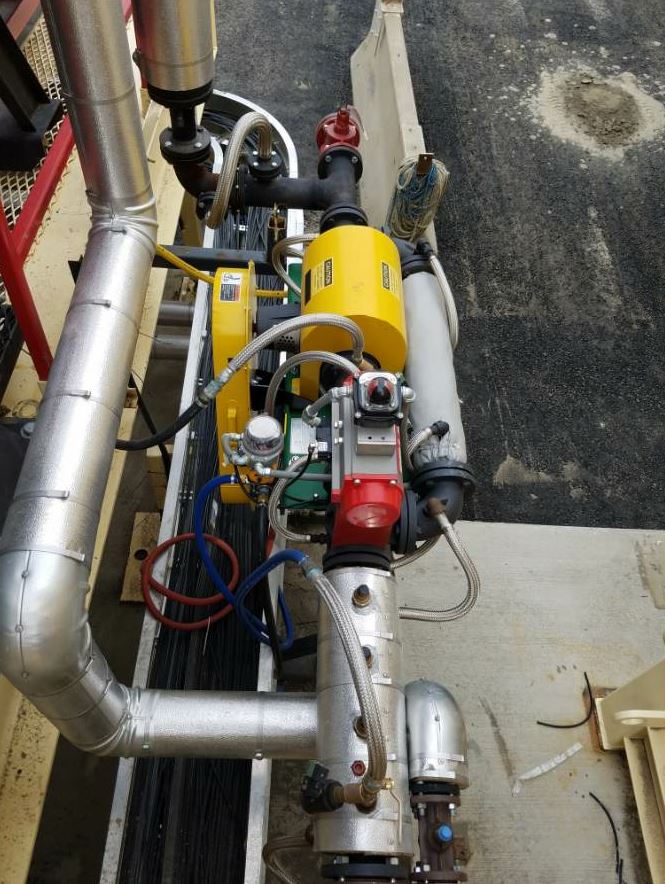
The Accu-Shear® from Stansteel/Hotmix Parts is installed in the asphalt injection line prior to the plant mixing zone.
The Accu-Shear® from Stansteel/Hotmix Parts, Louisville, Kentucky, is designed for multiple liquid additives and features advanced in-line water foaming of liquid asphalt cement (AC). The shearing process promotes total blending and homogenized flow for warm-mix asphalt (WMA) production. The Accu-Shear is also engineered for in-line blending of rejuvenators, latex, emulsions and most liquid chemicals on the market today with the optional four-port additive manifold. Here’s how it works.
First, a technician installs the Accu-Shear in the asphalt injection line prior to the plant mixing zone. From the control center, the operator selects a mix design that will activate and control each additive as required. The plant’s automation controls the production rate and flow rates of each liquid additive.
By normally using the 15-horsepower variable speed motor to force the material together, AC and water are blended mechanically, not injected. According to the manufacturer, this positive blending of the additives with the liquid AC increases the foaming action and maximizes coverage of the heated aggregate. The unit is designed for speedy calibration. The Accu-Shear has a unique sampling station capability to verify the foaming and test the blended AC prior to adding aggregates.
For more information about the Accu-Shear WMA technology, contact Rick Rees at (800) 826-0223 or visit www.stansteel.com.
Tarmac’s TRI-MIX

Here is the Tarmac TRI-MIX warm-mix injection system installed inline.
The TRI-MIX warm-mix injection system from Tarmac International Inc., Lee’s Summit, Missouri, is designed for dual use—the producer can set it up for water or chemical injection to create foamed liquid asphalt cement (AC) at lower production temperatures than hot-mix asphalt. Here’s how it works.
First, the operator sets the percentage of injected liquid into the controls, which will follow the production rate of the plant.
The variable frequency driven pump then delivers the liquid from the pump skid to the dual injection nozzles inserted on opposite sides of the static mixer. (The static mixer is located in the AC line before the entry into the drum mixer or pugmill.) The high pressure liquid spraying into the static mixer on opposite sides of the AC line provides full agitation for foaming the liquid AC to approximately 10 times its normal volume.
Three spiral flights located in the downstream nozzle section further mix the injected liquid and AC to make the foamed AC.
Once the AC is foamed, it continues down the existing AC pipe to enter the drum in the mixing area to coat the aggregate. When the liquid spray is not in use, the 40 psi compressed air supply is provided through the hose to the nozzles to prevent the AC from backing up into the system and clogging the injection nozzles and hose.
For more information, contact Tarmac’s sales team at (816) 220-0700.
